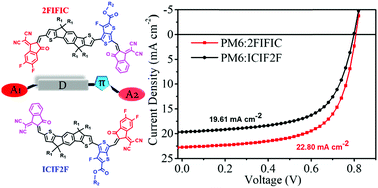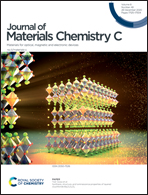Preparation of non-fullerene acceptors with a multi-asymmetric configuration in a one-pot reaction for organic solar cells†
Abstract
Asymmetric molecular configuration shows great potential in the design of non-fullerene acceptors (NFAs) for organic solar cells (OSCs). However, NFAs with multi-asymmetric factors are seldom explored and the structure–property relationship between different asymmetric isomers is unrevealed. Herein, two NFAs 2FIFIC and ICIF2F were rationally designed by simultaneously introducing an asymmetric bridge and a terminal group into the A1–D–π–A2 configuration. These two NFAs were synthesized in a one-pot reaction and separated facilely using silica gel column chromatography. Although 2FIFIC and ICIF2F have almost identical absorption profiles and similar energy levels, the diversity of asymmetry endows these two molecules with varied miscibility blending with the donor polymer PM6, leading to different morphology in blend films. The relatively low miscibility between 2FIFIC and PM6 enables their blend film to form a nanoscale fiber-like domain and stronger phase separation. This favorable morphology enhances the electron mobility and restrains charge recombination in PM6:2FIFIC devices, thus delivering a higher short circuit current density (Jsc), eventually providing a better PCE of 11.34% than that of ICIF2F based devices (9.60%). This work demonstrates that introducing multi-asymmetric factors into NFAs is a fruitful way of advancing OSCs, and the results revealed here are helpful in the design of new asymmetric NFAs.

- This article is part of the themed collection: Journal of Materials Chemistry C HOT Papers


 Please wait while we load your content...
Please wait while we load your content...